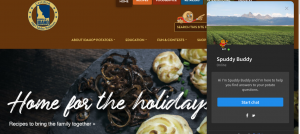It’s frustrating. You’ve spent a boatload of cash on customer service tech — chatbots. Unfortunately, your customer service department is still overwhelmed and overworked.
And yet, here you are. Still dealing with customer queries that the chatbot should’ve handled.
You wonder whether you were wrong to make the investments.
The truth? No, you weren’t
It’s projected that Chatbots will produce $8 Billion in savings by 2022.
So what could be the missing link? Consider your chatbot strategy.
But first, let’s find out if chatbots are useful for business.
Why Chatbots-Are they Useful For Business?
A Chatbot is a kind of software that mimics human conversation. Chatbots typically use Artificial Intelligence (AI) software and Natural Language Processing (NLP) to simulate conversation.
So are chatbots useful for business? The short answer? It’s complicated.
It all depends on your chatbot strategy.
Skeptical?
55% of users prefer fast responses. Chatbots also deliver savings by answering up to 80% of Frequently Asked Questions.
Having chatbots as part of your customer service strategy is inevitable. Chatbots save time and money, generate leads, and provide after-hours support.
Let’s take a look at Chatbot Marketing elements you can’t ignore.
Is Your Chatbot Marketing Strategy Ineffective? 4 Elements You Can’t Ignore
So how do you tell if your chatbot strategy is ineffective? You’ll need to understand a few KPI’s.
Chatbot activity volume helps you check whether the frequency of chatbot use. A low activity volume shows your target users don’t prefer chatbot use or find it unhelpful.
The bounce rate is the number of user sessions that fail to result in the chatbot’s specialized use. A high rate would show that users consult your chatbot on subjects outside its area of expertise.
Retention rate measures the number of users who’ve consulted your chatbot repeatedly over a specific period. This metric shows your chatbot’s relevance among your target audience.
The non-response rate measures how often your chatbot fails to respond to a user’s question. A high percentage is a red flag.
Knowing these few metrics, let’s outline chatbot strategy mistakes that could kill your business.
5 Chatbot Strategy Mistakes That Could Kill Your Business
Having a chatbot to grow your business—whether it’s to generate leads, assist existing customers, or build your brand—has become more popular than ever.
Here are some mistakes in your chatbot strategy that could kill your business.
#1: Poor Knowledge About Your Target Audience.
A chatbot’s goal is to automate communication and to enhance your brand’s customer experience. However, not learning about your target audience impacts your chatbot strategy negatively.
Your user experience should connect to the audience in a relatable way. Your chatbot should address frequently asked questions from your target audience.
Not sure where to start?
Consult your sales department and find out the major pain points of your target audience.
Survey your audience and analyze the language and words they use.
Your chatbot conversation should also be consistent across all channels. You must integrate your chatbot strategy into your overall customer experience technology. A lack of integration creates data silos—where your business doesn’t take into account data from other sources that support your target audience’s needs.
Your audience is the cornerstone of your chatbot strategy. Invest in understanding your audience.
#2: Wrong Chatbot Strategy Goals
Your chatbot strategy should begin with the end in mind. Does your chatbot strategy have specific achievable and realistic goals?
Ignore the hype— a chatbot isn’t a magic pill for your business.
Decide in advance what your chatbot should do for the audience. Also, consider what steps you would like them to take to create the best customer experience.
Consider whether your chatbot is capable of serving the end-to-end customer journey. To achieve this, have guided conversational experiences instead of open-ended questions. Questions should be specific with a specific action expected from the customer.
Keep your chatbot users focused on a conversational path that would enhance problem resolution and customer satisfaction.
#3: Poor Chatbot Design and Development
A conversation with a chatbot should not feel “robotic” despite Artificial Intelligence (AI) use. Your chatbot should not repel users.
Your chatbot design should have a human feel and experience.
Poor design may show up as the chatbot having too much personality, no personality, or a personality mismatched to your target audience.

Consider giving your chatbot a name, introducing polite mannerisms such as saying “hello” or “Good day,” and including some informal expressions, your target audience may use.
Your chatbot should also complement your brand in tone, voice, look, and feel. Moreover, your chatbot should have the ability to interpret what users are saying and answer user questions.
Poor design leads to the poor performance of the chatbot and negatively impacts your chatbot strategy.
#4: Lack of a Detailed Strategy
A chatbot is similar to a landing page. It can either attract leads or repel them. Consider whether visitors leave the site too quickly— a sign that the chatbot conversation isn’t focused on the right audience or doesn’t meet user expectations.
A successful chatbot strategy should have specific user actions that the chatbot will complete as it moves through the conversation.
Specific user actions manage the user journey and show your users that your chatbot can do some things but not all things.
A detailed strategy involves considering all the call to action (CTA’s) that you’d like to focus on as a brand.
#5: No Consideration of Platform Strengths
An effective chatbot strategy considers the best performing features and experiences on various platforms. A unique feature of chatbots is that they’re customized depending on the platform used.
For example, they may be personalized, structured to know what’s going on in the world or what they’ve said in previous conversations.
Is your chatbot strategy applicable on various platforms? Your chatbot strategy should consider platform strengths. For example, does the platform support Natural Language Processing (NLP) and click-based interactions?
Your chatbot strategy could conflict with the platform you’ve chosen. Consider sufficient testing to know which features to use while also testing for customer experience.
Get Ahead of Your Competition
Investing in chatbots without a clear Return on Investment (ROI) can be frustrating and draining.
Chatbots are here to stay—your chatbot strategy is what determines your success.
Chatbots need to be part of a more extensive customer experience journey. Consider a partner to support your brand’s end-to-end customer journey.
Skeptical? Please don’t take our word for it.
Get a demo and get ahead of your competition.
You’ve got this.


